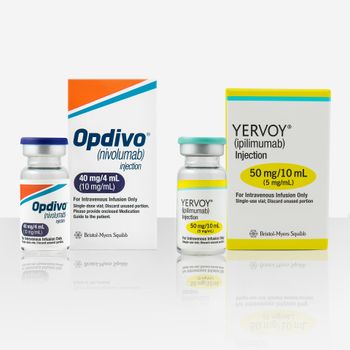
Early Trial of Libtayo Combination Demonstrates Activity in Melanoma
Fianlimab plus Libtayo demonstrated persistent and significant clinical activity in patients with advanced melanoma.
Fianlimab combined with cemiplimab-rwlc (Regeneron’s Libtayo) demonstrated persistent and significant clinical activity in patients with advanced melanoma, irrespective of LAG-3 or PD-L1 expression, according to results from a combined post hoc analysis of three independent cohorts from a phase 1 trial (NCT03005782) presented at the
Tumor responses in a combined cohort of 98 patients showed that at a median follow-up of 23 months, the overall response rate (ORR) was 57% (95% CI 47%-67%) including a complete response (CR) rate of 25% and a partial response (PR) rate of 33%. The rates of stable disease (SD) and progressive disease (PD) were 17% and 15%, respectively. Seven percent of patients were not evaluable (NE), and 3% of patients did not reach complete response or progressive disease.
Notably, 70% of patients experienced some level of tumor reduction. The median duration of response (DOR) was not reached (NR; 95% CI, 23–not estimable [NE]). The median progression-free survival (PFS) was 24 months (95% CI, 12-NE); the 12- and 24-month progression-free survival rates were 60% (95% CI, 49%-69%) and 49% (95% CI, 36%-62%), respectively. The median overall survival was NR (95% CI, 42-NE).
"With a longer follow-up of 23 months, fianlimab plus cemiplimab in patients with advanced melanoma showed persistent high clinical activity by BICR [blinded independent central review] assessment regardless of PD-L1 or LAG-3 status and across high-risk subgroups with an acceptable safety profile,” lead study author Meredith McKean, M.D., of Sarah Cannon Research Institute in Nashville, Tennessee, and colleagues, wrote in a poster presentation of the data.
The open-label, nonrandomized, multi-cohort expansion study enrolled patients at least 18 years of age with metastatic or locally advanced, inoperable non-uveal melanoma. Patients were divided into three distinct cohorts: the initial cohort (MM1) included 40 patients with first- or second-line advanced melanoma who had never received anti–PD-(L)1 therapy. The confirmatory cohort (MM2) consisted of 40 patients with first-line advanced melanoma who were also naive to anti–PD-(L)1 agents. The neoadjuvant/adjuvant experienced cohort (MM3) enrolled 18 patients who received prior perioperative systemic therapy, including 13 who had received anti–PD-(L)1 therapy.
All patients received fianlimab at 1,600 mg combined with cemiplimab at 350 mg once every 3 weeks for up to 24 months. The data cutoff for this analysis was Oct. 31, 2023.
The safety profile of the fianlimab plus cemiplimab was largely consistent with that observed for cemiplimab monotherapy and other anti–PD-(L)1 agents. However, study authors noted that treatment-related adrenal insufficiency of any grade occurred in 12% of patients, with 5% experiencing grade 3 or higher effects. Among patients who experienced any-grade adrenal insufficiency (n = 12), the ORR was 92%, (95% CI 62%-100%).
Adverse effects (AEs) of any grade occurred in 95% of patients. Grade 3 or higher AEs were reported in 47% of patients, serious AEs occurred in 36%, and immune-mediated AEs were noted in 13% of patients.
Reference
McKean M, Nye S, Papadopoulos K, et al. Long-term follow-up of advanced melanoma (unresectable/metastatic - aMel) patients treated with fianlimab (FIAN) + cemiplimab (CEMI): Results from blinded independent central review (BICR) efficacy assessment. Presented at: 2024 ESMO Congress; September 13-17, 2024; Barcelona, Spain. Abstract 1097P.
Newsletter
Get the latest industry news, event updates, and more from Managed healthcare Executive.


















































